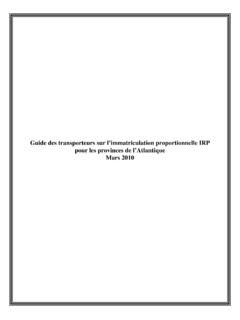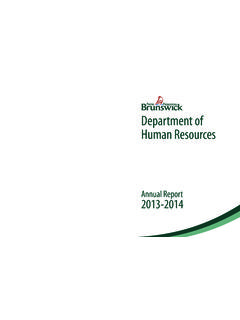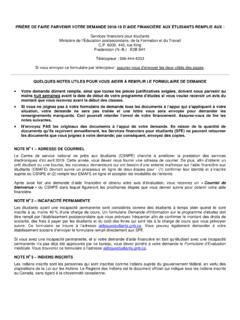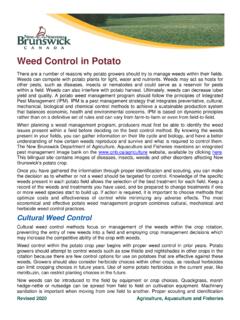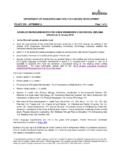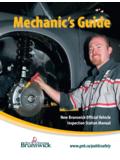Transcription of Foreward Air Brake Endorsement - gnb.ca
1 IiiAir Brake Endorsement permits the holder to drive vehicles equipped with air brakes in class of vehicle for which the driver is licenced. To adjust manual slack adjusters, the operator must hold an E Brake Endorsement . Requirements for Air Brake Endorsement Must complete an Air Brake Written Test. Must complete an Air Brake Practical Air Brake Manual has been prepared by the Department of Public Safety (Motor Vehicle Branch) to assist drivers in understanding the basic operation and function of an air Brake system . The study of this manual, together with practical instruction, is recommended for a driver who is preparing for the air Brake examination. A large illustration of a complete dual air Brake system is located on the inside cover and can be folded out and referred to when studying this manual. Study questions are included at the end of each section so that readers may self-test their understanding of the subject matter. Drivers who have qualified and are authorized to operate air Brake equipped vehicles are encouraged to review this manual on a periodic basis to ensure they are fully aware of the proper method of inspecting an air Brake system and identifying problems that can occur when the system illustrations and explanations of various types of Brake system designs are provided for instructional purposes only.
2 Most air gauges measure in imperial units. Therefore the measurements used and relating to the air Brake system will be in imperial units. This manual has no legislative sanction. For interpreting and applying the law, consult the Motor Vehicle Act and its gratefully acknowledge the contributions of all jurisdictions, particularly Brake ManualCe document est disponible en fran blue - supply/wet green - primary/dry red - secondary/dry yellow - spring parking Brake system dark green - trailer system In-cab portion is highlighted 1. Compressor 2. Governor 3. Air dryer 4. Safety valve 5. Supply/wet reservoir 6. Drain valves 7. One-way check valves 8. Primary/dry reservoir 9. Low pressure indicator 10. Secondary/dry reservoir 11. Rear service Brake chambers 12. Spring parking Brake chambers 13. Tractor relay valves 14. Trailer service Brake chamber 15. Trailer spring parking Brake chamber 16. Trailer reservoirs 17. Trailer relay valve 18. Trailer spring parking Brake valve 19.
3 anti -compound lines 20. Glad hands 21. Supply (emergency) line 22. Control (service) line 23. Spring Brake modulator valve 24. Tractor protection valve 25. Stop lamp switch 26. Two-way check valves 27. Spring parking Brake control valve 28. Trailer supply valve 29. Reservoir air pressure gauges 30. Trailer Brake hand valve 31. Foot valve 32. Front service Brake chambers 33. Quick release valve 34. Automatic front Brake limiting valveThis illustration has an automatic front Brake limiting valve (34), and therefore the control valve (35), for a manual front Brake limiting valve (36) are not shown here, but appear later in the THE SLACK!It is up to YOU, the DRIVER, to ensure that your vehicle has safe, properly adjusted Air Brake System1 Foreward Foldout iAir Brake Endorsement Foldout iiRequirements for Air Brake Endorsement Foldout iiDual Air Brake system Illustration Foldout iiiSafety tips 02 Making Appointments for Tests 03 Section One - Brakes and braking 05 Heat-Energy-Traction-Friction 06 Speed-Weight-Distance 07 braking Force 07 Stopping Distance 08 Section Summary Questions 09 Section Two - The Components of an Air Brake system 11 The Components of an Air Brake system 12 Compressor and Governor 12 Reservoirs 14 Air Dryer 15 Safety Valve 16 Foot Valve 16 Brake Chambers.
4 Slack Adjusters and Brake Lining 16 Wedge Brakes 20 Disc Brakes 21 Air-Over-Hydraulic Brake Systems 21 Section Summary Questions 24 Section Three - How the Basic system Works 25 Basic Air Brake system 26 One-way Check Valve 26 Air Pressure Gauge 27 Brake Application Gauge 27 Low Pressure Warning Device 27 Stop Light Switch 27 Quick Release Valve 28 Relay Valve 28 Manual Front Brake Limiting Valve 28 Automatic Front Brake Limiting Valve 29 Tandem Rear Axles 30 Section Summary Questions 30 Section Four - Spring Parking Brakes 31 Spring Parking Brake Systems 32 Using a Spring Parking Brake 33 Mechanical Release (Caging) 35 Section Summary Questions 35 Section Five - Trailer system 37 Glad Hands 38 Application Line 38 Trailer Brake Hand Valve 39 Two-way Check Valves 40 Tractor Protection system 41 Tractor Protection Valve 42 Trailer Supply Valve 43 Automatic Trailer Supply Valve system 44 Tractor and Trailer Coupled 46 Charging the Trailer system 47 Foot or Hand Valve Brake Application 47 Emergency Application 48 Supply (Emergency) Line Rupture 49 Control (Service) Line Rupture 49 Loss of Reservoir Air Pressure 50 Manual Trailer Supply Valve 51 Trailer Spring Parking Brakes 52 Section Summary Questions 52 Section Six - Dual Air Brake system 53 Dual Air Brake system with Spring Parking Brakes 56 Spring Parking Brakes with Modulator Valve 57 Combination Tractor and Trailer with Spring Parking Brakes 58 Section Summary Questions 59 Section Seven - Electronic Controlled braking and Traction Systems 61 anti -lock Brake system (ABS) 62 Automatic Traction Control (ATC)
5 64 Section Summary Questions 64 Section Eight - Brake Adjustment and In-Service Check 65 Brake Adjustment 66 S-cam Brake 66 Stroke vs. Force 67 S-cam Brake Adjustment with Manual Slack Adjuster 68 S-cam Brake with Automatic Slack Adjuster 68 Disc Brake Adjustment 68 Wedge Brake Adjustment 69 After a Brake Adjustment 69 In-service Checks 69 Maintenance and Servicing of the Air Brake system 70 Section Summary Questions 70 Section Nine - Pre-trip Air Brake Inspection 71 Single Unit (Not for air over hydraulic Brake systems) 72 Combination Unit 73 Air Over Hydraulic (Air Actuated) Brake system 75 Section Summary Questions 76 Metric Conversion Table 77 Table of Contents2 Safety tips 1. Reminder - is your commercial trailer equipped with the mandatory retro-reflective markings? In January 2002, under the motor vehicle inspection program, all trailers must now be equipped with retro-reflective markings. Be seen - be Seatbelts Save Lives - Please Buckle Up - The Life you Save May Be Your Own The proper use of occupant restraints has become the most cost-effective method to reduce death and injuries resulting from motor vehicle Animals on the Highways - Slow Down - Please Be Alert.
6 - Drivers should use caution especially at dawn and dusk when the animals are on the move. - Animals are unpredictable so reduce your speed. - Stay alert and scan both sides of the road, not just the pavement in front of your Cellular Phones - Cellular telephones are an important safety aid for drivers. Many people use their cellular telephone to report accidents and crimes and for their personal safety when their vehicle breaks down or they are lost. - Use a hands-free device to make it easier to keep both hands on the wheel. - When dialling manually, dial only when stopped, or have a passenger dial for you. - Avoid unnecessary calls and keep conversations to a minimum. - Be familiar with the various functions of your cellular phone and program frequently dialled numbers. - Do not use your cellular phone when driving conditions are hazardous. - Remember it is an offence under the Motor Vehicle Act to drive without due care and SEE AND BE SEEN! - Turn on your DRIVER DISTRACTIONS - Many everyday habits of drivers are dangerous and can lead to crashes.
7 Distractions such as eating fast food, drinking coffee, changing the radio station, switching CDs or tapes, talking on a cellular phone or trying to keep an eye on a young child in the vehicle increases the risk of being involved in a collision. All drivers should drive defensively and be prepared for the unsafe actions of other motorists or for poor driving conditions. Expect the Operation Lifesaver reminds all drivers to stay alert at all times and especially when crossing a railway track. - Be careful - low slung trailer units can get stuck on raised crossings. - Know the length of your truck and trailer. When you see a signal or stop sign be certain you have enough room to completely clear the railway tracks before Care of Yourself!The most important part of a moving truck or bus is the driver! Get plenty of rest before getting behind the wheel. Eat well and stay fit. Remember, hours of service violations are serious and can threaten your livelihood or even your life.
8 Stay healthy and well rested, or don t Maintain Your VehicleInspect your vehicle before each trip and check your brakes regularly. Learn how to inspect your brakes, identify safety defects, and get them repaired before risking your life and others on the Down in Work ZonesWatch out for highway construction. Stay alert. Work zone crashes are more likely to happen during the day. Almost one-third of fatal crashes in work zones involved large trucks. Take your time going through work zones and give yourself plenty of room. Expect the Keep Your DistanceAlways leave enough space between you and the vehicle in front of you. If you hit someone from behind, you are typically considered at fault , regardless of the situation. Large trucks require more stopping distances than other vehicles. Take advantage of your driving height, and anticipate braking Drive DefensivelyAvoid aggressive drivers! It is estimated that each year, two-thirds of all traffic fatalities are caused by aggressive driving behaviours Keep your distance and maintain a safe speed.
9 The only thing speed will increase is your chance for a to Help YourselvesBe the professional on the highway and at safety events! Help stranded motorists; notify traffic safety agencies of crashes, unsafe drivers, unsafe roadway conditions, and other situations that can lead to crashes. your participation in public safety events and your performance on the highway can change public perception!YOU RARELY RUN OUT OF BRAKES, BUT YOU RUN OUT OF ADJUSTMENT. (The Brake components could all be new but if the adjustment is not done, the brakes will not do their job.)Check the steering Brake air line - it s well worth the time. It is recommended that the airline that feeds the steering brakes be inspected for bulges, flat spots, cracks and looseness at the fitting. This is an important safety issue as a blown airline hose will result in rapid loss of air pressure and decreased ability to proper Brake operation and safety is the responsibility of the driver. Take time during the pre-trip inspection to check the brakes - it could prevent a serious related defects continue to be the most frequent reason commercial vehicles are put out-of-service.
10 The driver/carrier can make a difference by a) increasing knowledge of Brake compliance and vehicle Brake performance, and b) making sure all applicable Brake system inspection requirements are : Make sure that your brakes are properly adjusted Do not mismatch air chamber in size on the same axle. A properly installed air chamber and slack adjuster should not have more than a 90 degree angle between the components. Do not mismatch slack adjusters in length on the same Appointments for TestsContact your local Service New Brunswick office to arrange for an appointment and any additional information regarding testing ONE - BRAKES AND BRAKING6To stop the vehicle in 1/10 the time it took to accelerate would require a stopping force of 10 times the acceleration force the equivalent of approximately 2,000 horsepower. If the vehicle had six wheels, each wheel would have to provide 1/6 the braking force. If one or two of the wheels had brakes that were not properly adjusted, the other wheels would have to do more than their share of the braking , and that might be more than their brakes were constructed to stand.
